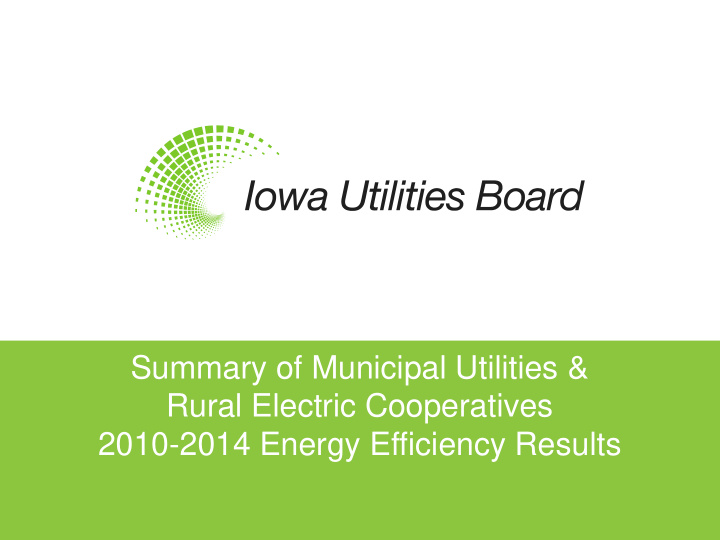



Summary of Municipal Utilities & Rural Electric Cooperatives 2010-2014 Energy Efficiency Results
Background • Iowa Code § 476.6(15)(c)(1)-(4) directed utilities: (those utilities not required to be rate-regulated - such as the municipal utilities and rural electric cooperatives) – To assess the maximum potential of energy and capacity savings. – To establish energy efficiency goals based upon that assessment of potential. – To establish cost-effective energy efficiency programs designed to meet their goals. • Initial progress reports were due by January 1, 2009, with the final reports due by January 1, 2010. • On-going reports are due by January 1 of each even-number year beginning January 1, 2012. – The reports are to identify their progress in meeting the energy efficiency goal and to provide updates or amendments to their energy efficiency plans and goal. 2
Background • Iowa Code §476.6(15)(d)(1)-(3) directed the Board to: – Evaluate the reports filed by the utilities not required to be rate regulated. The Board submitted reports to the General Assembly (dated January 1, 2011) summarizing the evaluation of the municipal utilities’ and rural electric cooperative’s reports. The Board is not required to submit any other reports (related to this statute) to the General Assembly. 3
Municipal Utilities’ Energy Efficiency Plan/Actual Spending - Electric $8,000,000 $7,000,000 $6,000,000 $5,000,000 $4,000,000 $3,000,000 $2,000,000 $1,000,000 $0 2010 2011 2012 2013 2014 2015 2016 2017 Plan Spending Actual Spending 4
Municipal Utilities’ Energy Efficiency Plan/Actual Savings – Electric (MWh) 50,000 45,000 40,000 35,000 30,000 25,000 20,000 15,000 10,000 5,000 - 2010 2011 2012 2013 2014 2015 2016 2017 Plan Savings Actual Savings Savings reflected are incremental annual savings. 5
Municipal Utilities’ Energy Efficiency Plan/Actual Spending – Natural Gas $1,400,000 $1,200,000 $1,000,000 $800,000 $600,000 $400,000 $200,000 $0 2010 2011 2012 2013 2014 2015 2016 2017 Plan Spending Actual Spending 6
Municipal Utilities’ Energy Efficiency Plan/Actual Savings – Natural Gas (Therms) 600,000 500,000 400,000 300,000 200,000 100,000 - 2010 2011 2012 2013 2014 2015 2016 2017 Plan Savings Actual Savings Savings reflected are incremental annual savings. 7
Summary of Municipal Utilities’ Energy Efficiency Plan/Actual Spending & Savings 2010-2014 % of 2010-2014 % of Electric Goal Natural Gas Goal Plan Spending $31,300,000 $5,500,000 Actual Spending $28,900,000 92.3% $3,700,000 67.4% Plan Savings 203,500 MWh 2,100,000 therms Actual Savings 164,600 MWh 80.9% 1,600,000 therms 76.8 % These totals reflect data filed by the IAMU for 135 municipal electric utilities and 50 municipal natural gas utilities; Story City Municipal Electric; and Lineville Natural Gas System. 8
Municipal Utilities’ “Factors in Success” Communities that exceeded their goal: 1. Sought opportunities for innovative approaches to energy efficiency; 2. Tailored their approach to the local demography and customer base; and 3. Participated in joint action to leverage technical expertise and to achieve economies of scale. 9
Municipal Utilities’ Energy Efficiency Challenges – Declining and aging populations. – Few commercial customers. – Few housing starts. – Limited staff time. – “Lumpy” savings – large projects are not typically undertaken every year. 10
Typical Energy Efficiency Programs for Municipal Utilities • Residential Lighting program. • Residential/Small Commercial Energy Star Appliance Incentives. • Residential Prescriptive Incentives for high efficiency heating, cooling and water heating equipment. • Residential Energy Audits and Weatherization Incentives. • Commercial and Industrial Prescriptive Incentives for lighting, motors and drives, heating, cooling and water heating equipment and commercial kitchen equipment. • Commercial and Industrial Custom Incentive program. • Direct Load Control (Residential and Nonresidential) • Customer Education. • LED street lighting. 11
REC’s Energy Efficiency Plan/Actual Investment (Spending) – Electric $20,000,000 $18,000,000 $16,000,000 $14,000,000 $12,000,000 $10,000,000 $8,000,000 $6,000,000 $4,000,000 $2,000,000 $0 2010 2011 2012 2013 2014 2015 2016 2017 Plan Investment/Spending Actual Investment/Spending The RECs have filed energy efficiency plans through 2019. 12
REC’s Energy Efficiency Plan/Actual Savings – Electric (MWh) 80,000 70,000 60,000 50,000 40,000 30,000 20,000 10,000 - 2010 2011 2012 2013 2014 2015 2016 2017 Plan Savings Actual Savings Savings reflected are incremental annual savings. 13
Summary of REC’s Energy Efficiency Plan/Actual Investment & Savings 2010-2014 Electric % of Goal Plan Investment/Spending $86,600,000 Actual Investment/Spending $79,800,000 92% Plan Savings 300,900 MWh Actual Savings 326,700 MWh 108% These totals reflect data filed by the IAEC for 37 rural electric cooperatives and data filed by Maquoketa Valley Electric Cooperative. 14
Rural Electric Cooperatives • Electric markets served by the Iowa rural electric cooperatives are different from markets served by other utilities and are different from cooperative to cooperative. • Key Challenges: – Higher percentage of residential customers served. – Significantly newer commercial and industrial member-consumers. – Lack of penetration of natural gas as the primary home heating fuel in rural areas. – Very few members per mile of power line. 15
Typical Energy Efficiency Programs for RECs • Residential Lighting program. • Residential Energy Star Appliance Incentive program. • Residential Prescriptive Incentives for high efficiency heating, cooling and water heating equipment. • Residential Energy Audits and Weatherization Incentives. • Commercial/Agriculture and Industrial Prescriptive Incentives for lighting, motors and drives, heating, cooling and water heating equipment and agricultural equipment. • Commercial/Agriculture and Industrial Custom Incentive program. • Demand Response. • Customer Education. 16
Recommend
More recommend